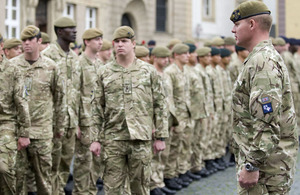19 Light Brigade and 20th Armoured Brigade celebrate Afghanistan homecoming
More than 500 soldiers from both 19 Light Brigade and 20th Armoured Brigade marched through the centre of Paderborn in northern Germany last week to celebrate their homecoming from Afghanistan.

Soldiers from 1st Battalion The Princess of Wales's Royal Regiment fall out from being on parade in Paderborn [Picture: Corporal Wes Calder RLC, Crown Copyright/MOD 2012]
Led by the Band of the Parachute Regiment and the drum horse from the Queen’s Royal Hussars, the homecoming parade marked the end of their six-month tour in Afghanistan on Operation HERRICK 15.
All the regiments and battalions have had their own medal parades but this was a chance to mark an important occasion and gain some closure on this, their most recent, deployment.
Whilst the operation finished in the spring of 2012, elements of the brigades remained in theatre for up to six weeks after the official handover to HERRICK 16, which is being led by 12th Mechanized Brigade.
Brigadier Patrick Sanders, who led 20th Armoured Brigade on their deployment, was unable to attend but passed on his thanks through Brigadier James Swift, his successor, who emphasised the success of the tour and all that had been achieved.
These achievements included the handover of Lashkar Gah to Afghan security forces control and Nad ‘Ali moving to Afghan security control earlier than expected; meaning that two of the three Helmand districts British forces operate in are now under Afghan control.
In Afghanistan the brigade consisted of soldiers from every part of the UK and this was reflected in the parade in Paderborn. Soldiers came from Scotland, England and Northern Ireland to join their Germany-based counterparts for the celebration.
20th Armoured Brigade, which formed the core of HERRICK 15, lives alongside the people of Paderborn and contributes greatly to the diversity of the city. The people of Paderborn view the British soldiers based there as their own and thousands of well-wishers lined the streets of the city centre to cheer the soldiers on.
The Burgermeister (Mayor) of Paderborn, Heinz Paus, reinforced this relationship with his reflections on the last six months, concluding that:
coming out to see this parade is an expression of thanks from the people of Paderborn.
After a 20-minute march around the city centre, Herr Paus and Brigadier Swift took the salute outside the town hall.
The parade then came to a halt outside the city’s cathedral where Brigadier Swift gave his address, thanking the people of Paderborn for supporting the families of those who had deployed. In a final gesture he asked those present to join him in a round of applause to thank the soldiers and their families for the work they had individually undertaken.
The six-month tour was not without its costs; out of the 7,500 that deployed, tragically 23 soldiers were killed. As the names of those who had paid the ultimate sacrifice were read out, each was accompanied by a single toll of the cathedral bell.
Corporal Ross, from 3rd Battalion The Royal Regiment of Scotland, read out the words of John Maxwell Edmonds, written in 1918 and immortalised on the Second World War Kohima Memorial. Although used for many war memorials the words rang ever true for the young soldiers of today:
When you go home, tell them of us and say: for their tomorrow we gave our today.
Whilst the historic cathedral has its own story, the array of berets and cap badges was particularly significant as the Army 2020 announcement took place on the same day.
Acknowledging this in his speech Brigadier Swift said:
Army 2020 will take place over a period of time. I have inherited a good team and we now look forward to the future. You have your enduring camaraderie in your regiments and today I congratulate you for all that you have done.
Please tell us what you think about government news on the web by filling in the short survey at Related Links.